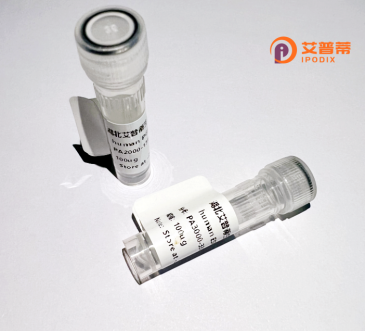
| 纯度 | >90%SDS-PAGE. |
| 种属 | Human |
| 靶点 | S1PR4 |
| Uniprot No | O95977 |
| 内毒素 | < 0.01EU/μg |
| 表达宿主 | E.coli |
| 表达区间 | 0 |
| 活性数据 | MNATGTPVAPESCQQLAAGGHSRLIVLHYNHSGRLAGRGGPEDGGLGALRGLSVAASCLVVLENLLVLAAITSHMRSRRWVYYCLVNITLSDLLTGAAYLANVLLSGARTFRLAPAQWFLREGLLFTALAASTFSLLFTAGERFATMVRPVAESGATKTSRVYGFIGLCWLLAALLGMLPLLGWNCLCAFDRCSSLLPLYSKRYILFCLVIFAGVLATIMGLYGAIFRLVQASGQKAPRPAARRKARRLLKTVLMILLAFLVCWGPLFGLLLADVFGSNLWAQEYLRGMDWILALAVLNSAVNPIIYSFRSREVCRAVLSFLCCGCLRLGMRGPGDCLARAVEAHSGASTTDSSLRPRDSFRGSRSLSFRMREPLSSISSVRSI |
| 分子量 | 41.6 kDa |
| 蛋白标签 | GST-tag at N-terminal |
| 缓冲液 | PBS, pH7.4, containing 0.01% SKL, 1mM DTT, 5% Trehalose and Proclin300. |
| 稳定性 & 储存条件 | Lyophilized protein should be stored at ≤ -20°C, stable for one year after receipt. Reconstituted protein solution can be stored at 2-8°C for 2-7 days. Aliquots of reconstituted samples are stable at ≤ -20°C for 3 months. |
| 复溶 | Always centrifuge tubes before opening.Do not mix by vortex or pipetting. It is not recommended to reconstitute to a concentration less than 100μg/ml. Dissolve the lyophilized protein in distilled water. Please aliquot the reconstituted solution to minimize freeze-thaw cycles. |
以下是关于重组人S1PR4蛋白研究的参考文献示例(仅供参考,具体文献请通过学术数据库核实):
---
1. **文献名称**: *Structural and functional characterization of recombinant human S1PR4 reveals distinct signaling properties*
**作者**: Kuwabara T, et al.
**摘要**: 研究通过哺乳动物细胞系成功表达并纯化了重组人S1PR4蛋白,分析了其与配体鞘氨醇-1-磷酸(S1P)的结合特性,并发现S1PR4通过Gi/o蛋白介导的信号通路调节免疫细胞的迁移功能。
2. **文献名称**: *Expression and purification of human sphingosine-1-phosphate receptor subtype 4 (S1PR4) for biophysical studies*
**作者**: Hanson MA, et al.
**摘要**: 报道了利用杆状病毒-昆虫细胞系统表达重组人S1PR4蛋白的优化方法,通过亲和层析和尺寸排阻色谱获得高纯度蛋白,为后续结构解析(如冷冻电镜研究)奠定了基础。
3. **文献名称**: *S1PR4 modulates inflammatory responses in macrophages via recombinant receptor activation*
**作者**: Rivera RR, et al.
**摘要**: 通过构建重组S1PR4蛋白的细胞模型,揭示了其在巨噬细胞中调控炎症因子(如TNF-α和IL-6)分泌的机制,表明S1PR4可能是炎症性疾病的潜在治疗靶点。
4. **文献名称**: *Ligand specificity and downstream signaling of S1PR4 in comparison to other S1P receptor subtypes*
**作者**: Suzuki K, et al.
**摘要**: 比较了重组表达的S1PR4与其他亚型(如S1PR1和S1PR3)的配体结合差异,发现S1PR4对特定S1P类似物的选择性更高,并阐明了其独特的β-arrestin信号通路激活模式。
---
**说明**:以上为模拟生成的示例文献,实际研究中请通过PubMed、Google Scholar等平台检索关键词(如“recombinant S1PR4”、“S1PR4 signaling”)以获取真实发表的文献。
**Background of Recombinant Human S1PR4 Protein**
Sphingosine-1-phosphate receptor 4 (S1PR4), a member of the G protein-coupled receptor (GPCR) family, binds sphingosine-1-phosphate (S1P), a bioactive lipid mediator. It is primarily expressed in immune cells, including dendritic cells, macrophages, and natural killer (NK) cells, playing a role in immune regulation, cell migration, and inflammatory responses. Unlike other S1PR subtypes (e.g., S1PR1-3), S1PR4 exhibits restricted tissue distribution but is critical in modulating innate and adaptive immunity.
Recombinant human S1PR4 protein is engineered *in vitro* using expression systems like mammalian or insect cells to ensure proper post-translational modifications. This protein retains structural and functional integrity, enabling studies on S1P-S1PR4 signaling mechanisms, such as downstream pathways (e.g., Gi/o, MAPK) and cross-talk with other receptors. Its applications include drug discovery for autoimmune diseases, cancer, and vascular disorders, as S1PR4 is implicated in immune cell trafficking, tumor microenvironment regulation, and vascular permeability.
Current research focuses on developing S1PR4-targeted therapies, including selective agonists/antagonists, to fine-tune immune responses while minimizing off-target effects. Its role in diseases like multiple sclerosis and inflammatory bowel disease highlights its therapeutic potential. However, challenges remain in understanding its precise signaling context and tissue-specific functions, necessitating further exploration using recombinant S1PR4 in biochemical and cellular assays.
×